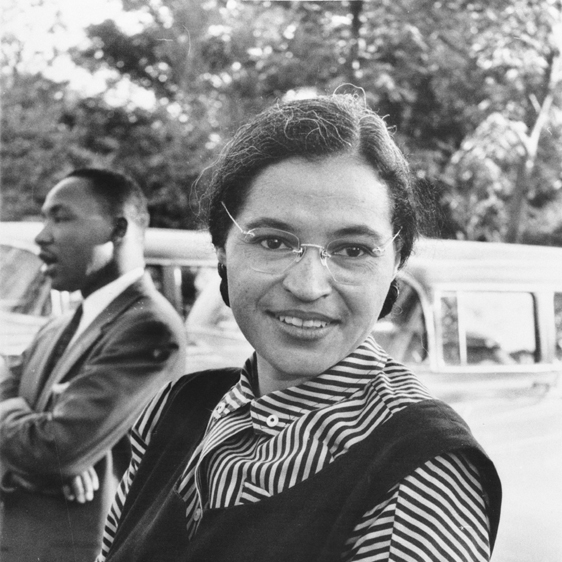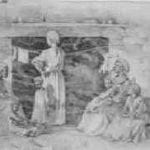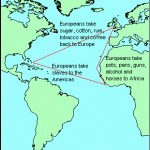Black history is the story of millions of African Americans residing in the United States who have struggled for centuries to fully claim the promises of liberty granted in the founding documents of the United States. The majority are descendants of Africans brought to the New World as property in the Atlantic slave trade. Their story is one of slavery, emancipation, reconstruction, Jim Crow-era disenfranchisement, and the civil rights movement. Through all these centuries, Black Americans have made extraordinary culture contributions to the United States in the areas of theatre, music, film, literature, and every other area of creative expression.
Click here to see more posts in this category.
Scroll down to see more information about black history in the United States.
Black History: Slavery
“The History of Slavery, Part 4: African Slavery in the New World, 1500-1865”
For the full “History Unplugged” podcast, click here!
When we think about Africa today, we think of it as a poor third-world continent, reliant on the charity of Western nations to survive. This has not always been the case. In terms of black history, it was during the sixteenth and seventeenth centuries, when Europeans first began exploring the world, Africa was a rich continent, eager to trade her gold, copper, ivory and leather goods for the white man’s pots, pans, alcohol and guns.
Under African law, slavery was a punishment for serious crimes, but most of these slaves were slaves of other black Africans. It was not usual for slaves to be traded at this time.
In 1492, Christopher Columbus discovered the Americas. Other Europeans followed and made slaves of the native peoples living there. However, the Europeans also took Western diseases to the Americas and their slaves began dying. Another source of slaves had to be found.
From trading with the Africans, Europeans knew that slavery was used as a punishment in Africa. They began to ask for slaves, rather than African goods, in exchange for the guns and alcohol that the African chiefs wanted.
Slavery was not new to Africa. Traditionally, slavery was used as a punishment for serious crimes. However, although slavery was a punishment for criminals, they were, in the main, treated fairly well by their masters.
This was not the case once trading in slaves became ‘big business’. From about 1510, Europeans had begun capturing slaves and taking them to work in the Americas. They were easily able to do this because their weapons were much more powerful than the Africans’ traditional spears and shields.
As the demand for slaves grew, the demand for slaves by Europeans grew. They exchanged guns for slaves and African chiefs, eager to possess guns that would give them power over rival chiefs, began inventing new crimes for which the punishment was slavery.
At the same time, coastal Africans were using guns to raid inland villages for the slaves that the Europeans wanted. Those who resisted capture were killed.
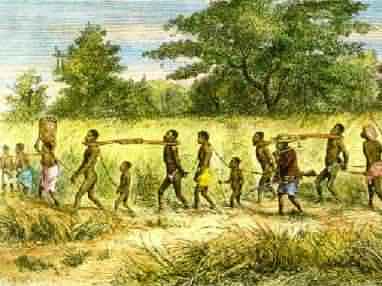
Slaves were chained together and marched to the coast. Sometimes this could take many days or weeks. Slaves who did not move fast enough, or showed any sign of resistance to the traders, were whipped. Those who were too weak or sickly to complete the journey at the required pace were left to die. Fear of the slave trader led many Africans to move to remote areas where the soil was not so good and they were unable to grow enough crops to feed themselves.
Tthe Triangular Trade was developed. This was the name given to the trading route used by European merchants who exchanged goods with Africans for slaves, shipped the slaves to the Americas, sold them, and brought goods from the Americas back to Europe.
Merchants who traded in this way could get very rich indeed as American goods fetched a high price in Europe. It was called the triangular trade because of the triangular shape that the three legs of the journey made.
The first leg was the journey from Europe to Africa where goods were exchanged for slaves. The second, or middle, leg of the journey was the transportation of slaves to the Americas. It was nicknamed the ‘middle passage.’
The third and final leg of the journey was the transport of goods from the Americas back to Europe.
The transport of black Africans to the Americas by slave ship became known as the Middle Passage because it was the middle leg of the Triangular Trade route used by the European merchants.
The African slaves were viewed as cargo by the merchants and were packed into the ships with no regard to their basic human rights. Slave ships could be either ‘tight pack’ or ‘loose pack’. A ‘tight pack’ could hold many more slaves than the ‘loose pack’ because the amount of space allocated to each slave was considerably less, but more slaves would die on route to the Americas.
Many slaves became seasick or developed diarrhea. Unable to move because they were chained into their positions, the slave’s deck became a stinking mass of the human waste. Slaves who had developed sores where their chains had rubbed their skin, had festering wounds often with maggots eating away their flesh.
Conditions on the slave ships were so bad that many slaves decided they would prefer to die and tried to starve themselves by refusing to eat or by jumping overboard. However, slaves that would not eat were whipped or force-fed and the traders and ship owners began fixing nets to the sides of the boat so that the slaves could not jump overboard. They had no choice but to endure the horrific conditions.
Black History: Antebellum America
Once in the Americas, slaves were sold, by auction, to the person that bid the most money for them. It was here that family members would find themselves split up, as a bidder may not want to buy the whole family, only the strongest, healthiest member.
Slave Auctions were advertised when it was known that a slave ship was due to arrive. Posters like the one pictured above would be displayed around the town.
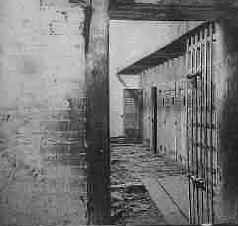 When the slave ship docked, the slaves would be taken off the ship and placed in a pen like this one. There they would be washed and their skin covered with grease, or sometimes tar, to make them look more healthy. This was done so that they would fetch as much money as possible. They would also be branded with a hot iron to identify them as slaves.
When the slave ship docked, the slaves would be taken off the ship and placed in a pen like this one. There they would be washed and their skin covered with grease, or sometimes tar, to make them look more healthy. This was done so that they would fetch as much money as possible. They would also be branded with a hot iron to identify them as slaves.
There were two main types of slave Auction:
1. Those that sold to the highest bidder
2. Grab and go Auctions
The slaves would be brought from the pen, in turn, to stand on a raised platform so that they could be seen by the buyers. Before the bidding began, those that wished to, could come up onto the platform to inspect the slaves closely. The slaves had to endure being poked, prodded and forced to open their mouths for the buyers.
The auctioneer would decide a price to start the bidding. This would be higher for fit, young slaves and lower for older, very young or sickly slaves. Potential buyers would then bid against each other. The person who bid the most would then own that slave. The picture below shows a slave being auctioned to the highest bidder.

Black History – The Founding Fathers and Slavery
(See Main Article: The Founding Fathers and Slavery)
“Making Sense of America’s Worst Moments: Jon Meacham on Understanding — But Not Excusing — Slavery and the Indian Removal Act”
For the full “History Unplugged” podcast, click here!
African American Struggles. In the South, of course, slavery was a fact of life. The overwhelming majority of black people (about 95 percent) lived in the South. But Southerners, particularly Virginians, were vexed by the institution. Washington, Jefferson, and Madison cursed slavery, and George Mason called the slave trade the “nefarious traffic” and thought that “every master of slaves is born a petty tyrant.” Washington, Jefferson, Madison, and Mason (among others) are deemed hypocritical, because they denounced slavery but did not free their own slaves. But they were no more hypocritical than Benjamin Franklin, who at one time owned slaves and then argued for abolition.
The real dividing line is that the South had to wrestle with the reality that slaves were not only central to the Southern agricultural economy, but were an actual numerical majority in some states (at least in some periods), and certainly a large minority in others. In 1790, for instance, slaves made up at least 40 percent of the population of both Virginia and South Carolina. To leaders in the South, the granting of freeman status to hundreds of thousands of slaves who were by no means grounded in the English tradition of inherited rights and moral duties would have imperiled the very liberty they were trying to guarantee; it would have, in their view, overturned the Republic into a mobocracy. For Southerners, it was, as Jefferson would later say, a case of justice being on the one side and self-preservation on the other.
Black History: Living Conditions of Slaves in the American South
(See Main Article: The Living Conditions of Slaves in the American South)
The living conditions of slaves in the antebellum American South were some of the worst for slaves across black history. As legal property of their masters they had no rights themselves and fared far worse than Roman slaves or medieval serfs. Perhaps only slaves in sugar cane plantations in the Caribbean fared worse. Africans sold as slaves in the Americas had to rely on their owners providing them with housing or building materials, pots and pans for cooking and eating, food and clothing. Many slaves did the best they could with what they were given. Most did not dare complain about their living condiitons for fear of receiving a whipping or worse punishment.
“The Lives of Slaves, Heretics, Cave-Dwellers, and Other People Ancient History Never Tells You About—Robert Garland”
For the full “History Unplugged” podcast, click here!
Black History – Housing
Slaves were allocated an area of the plantation for their living quarters. On some plantations the owners would provide the slaves with housing, on others the slaves had to build their own homes. Slaves that had to build their own houses tended to make them like the houses they had had in Africa and they all had thatched roofs. Living conditions were cramped with sometimes as many as ten people sharing a hut.
They had little in the way of furniture and their beds usually made of straw or old rags.
Slaves who worked in the plantation house generally had slightly better housing nearer to the house and were given better food and clothing than those slaves that worked in the fields.
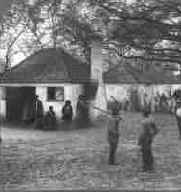
Black History – Food
Sometimes they were given pots and pans for cooking, but more often they had to make their own. The long hours they had to work in the fields meant that they had little free time for making things to improve their living conditions. Some slaves used a hollowed out pumpkin shell called a calabash, to cook their food in.?
Most plantation owners did not spend more money on food for their slaves than they had to and so the slaves lived on a diet of fatty meat and cornbread.
Black History – Clothing
Slaves would be given one pair of shoes and three items of underwear a year. Although these and other clothing would be provided by their owner, they were often ill-fitting and made of coarse material
Black History – Free Time
Most slaves had to work from sunrise to sunset. Some owners made their slaves work every day, others allowed slaves one day a month off and some allowed their slaves to have Sundays as a rest-day.
Slaves would spend their free time mending their huts, making pots and pans and relaxing. Some plantation owners allowed their slaves a small plot of land to grow things to supplement their diet.
Slaves were not allowed to read or write, but some were allowed to go to church.
Black History: Work Done By Slaves
(See Main Article: Slaves Work and Work Done By Slaves)
In the antebellum American South, by law slaves had no say in what task they were required to do, as by legal definition they were considered property and afforded none of the constitution, civil, or criminal legal protections afforded to any citizen of the United States.
They also had no control over the length of their working day, which was usually from sun-up in the morning to sunset in the evening (“can see to can’t see” in the slaves’ language). As such, slaves work was whatever their owner required of them. They labored mostly in menial agricultural work, but really in whatever task that was not so totally unnecessary that a machine could not do it for a fraction of the price. Since the South was lightly industrialized at this time, few tasks fit this criteria.
Although slaves were used in the northern states in factories to produce manufactured goods, at least prior to those states abolishing slavery, most slaves worked on plantations in the southern states.
Slaves were used on plantations for a variety of tasks:
 |
 |
 |
| Picking cotton |
Harvesting Sugar Cane |
Planting and Harvesting Rice |
 |
 |
 |
| Harvesting Tobacco | Growing and Harvesting Coffee | Building Railroads |
 |
 |
 |
| Working in the Dairy | Weaving | Carpentry |
| It was usually young girls that churned the milk into butter. | “My mammy was a fine weaver and she work for both white and colored.” | “He used to make spinning wheels and parts of looms. He was a very valuable man.” |
 |
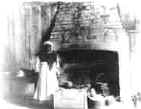 |
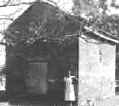 |
| Washing Clothes | Cooking | Butchering and Preserving |
| ‘I used battling blocks and battling sticks to help clean the clothes when we was washing’ | ‘The cooking was done in the kitchen in the yard.’ | Meat was butchered by the slaves, then preserved in the smokehouse |
Black History: Olaudah Equiano
(See Main Article: Black Peoples of America – Olaudah Equiano)
In regards to black history, the autobiography of Olaudah Equiano provides us with a detailed insight into the experience of a captured slave. The following account was adapted from Equiano’s The Interesting Narrative of Olaudah Equiano or Gustavus Vassa the African by H. Wheeler.
Capture
Olaudah Equiano was born in 1745 in the African country that is now Nigeria. The adults worked in the fields during the day leaving the children to fend for themselves in the village. Older children were often given the task of acting as lookouts and if they saw any traders approaching the village they would let out a loud cry. ‘AIEEEEEEEYAH!’
Olaudah and his sister were in the hut when they heard the cry. Looking out of the door, Olaudah saw the traders hurrying into the village and knew that there was no time for them to reach the safety of the trees. He and his sister crouched in the corner of the hut and held their breath. Their hearts were pounding and their ears were strained for the sound of approaching footsteps that surely enough came their way. Both Olaudah and his sister were roughly seized and their mouths were stopped with dirty cloths to stop them from crying out. Sacks were placed over their heads and they were carried away from the village. After a while they were put down on the ground and their hands were tied behind their backs. The sacks were replaced over their heads and again they were carried until nightfall.?
Although they were offered food that first night the children were unable to eat. They felt too sick from fear, the dirty rags that had been in their mouths and the confinement of the sacking over their heads.
After a few days they reached a larger African settlement and here Olaudah and his sister were separated and sold to different families. During the seven months that Olaudah spent in slavery in Africa he was mostly treated kindly, in some cases as part of the family, and was given fairly simple household tasks to do. In Africa slaves were respected and their status as part of the family was valued. Olaudah was soon to discover that slavery in America was very different.
The Crossing – Middle Passage
Eventually he was sold to another trader. Olaudah was marched many miles and saw the landscape change. He was soon shocked to see that the land had changed to the colour of the sky and appeared to be moving up and down. Olaudah was very frightened and had to be dragged nearer to the sea. He then noticed a very big ‘house’ on the moving land. The people around the big ‘house’ looked very strange. They had long hair, white skin and spoke a strange language. Olaudah thought that they were devils.
Because of his youth Olaudah was not chained like the men and women but he was dragged aboard the ship. There he saw a large copper pot above a furnace and fearing that he was going to be boiled alive and eaten by the white men, he fainted on the deck. When he came round black men were standing over him and he was reassured that he was not going to be eaten. As Olaudah looked back towards the shore he saw that he was moving away from the shoreline and realised that he would never see his homeland again.
Suddenly all the slaves were forced below deck. The hold was overcrowded, each man only had about eighteen inches space in which to sit. Everywhere people were sweating, vomiting, urinating and defecating from fear and the movement of the ship. The smell was overpowering and many fainted or died from the stale air. There were tubs at one end of the hold, which served as toilets but they were rarely emptied and often small children would fall in and drown. Olaudah was so ill from the smell and the conditions in the hold that he was allowed to sit on deck during the day to breathe fresh air. All he wanted to do though was to die. He was unable to jump overboard because of the nets on the sides of the boat so he refused to eat. He was beaten for not eating and not wishing to be punished again he began to eat some food.
The Indies
Eventually the ship reached the West Indies and although many slaves had died on the crossing many remained alive. Merchants and plantation owners came aboard the ship to look at the slaves and Olaudah was made to jump up and down and stick his tongue out by one of the men. Slaves were poked and prodded all over their bodies by potential owners who wanted to be sure that they got the healthiest slaves.
The next day the slaves were taken ashore and Olaudah was amazed to see that the houses were made out of bricks. He was even more amazed to see people riding horses and this served to enhance his belief that the white peoples were devils.?
All the slaves were put into a pen like a sheep pen. Suddenly there was a beat of a drum and merchants and plantation owners rushed up to the pen to choose the slave that they wanted. Because he was so sickly Olaudah was one of the last to be chosen. He was taken to a big house and was deposited in the kitchen. Here the sight of the Negro Cook who had a huge wire frame fitted around her mouth shocked him. He was later to learn that the mask was a punishment for too much talking.
Olaudah was not strong enough to work in the fields and so was given the task of sitting with the grandfather of the house who was dying. All day long he had to sit on a hard wooden chair ready in case the old man wanted anything. He also had to help feed him.
His day was very boring, sat in the deathly quiet room with only the ticking of the clock for company tick-tock-tick-tock-tick- tock punctuated by the groaning and moaning of the old man as he fought to draw breath. Meal times broke the monotony but turned Olaudah’s stomach as he spoon-fed soup to the old man who dribbled and coughed and spluttered all over him.
The Merchant and Freedom
When the old man died Olaudah was sold to a sea Captain who allowed the sailors on board the ship to teach him to read and to write. Although he was very well treated by the merchant, Olaudah longed to be free and to return to his homeland. He began buying fruit before sailing and selling it on to the sailors for a small profit. Eventually he saved enough to buy his freedom.
As a free man, he settled in England. He met Granville Sharp and the other members of the Society for the Abolition of Slavery. He made public speeches, giving a first-hand account of the treatment of slaves during capture, sea passage and slavery. Slavery was abolished in Britain in 1807 and throughout the Empire in 1833. Olaudah eventually travelled back to Nigeria to find his homeland, but sadly there was no trace of his village or his family.
Black History and the Civil War: Robert Gould Shaw (1837-1863)
(See Main Article: Black Peoples of America – Robert Gould Shaw (1837-1863) )
Robert Shaw was serving as a Captain in the 2nd Massachusetts when he was asked to raise and command a regiment of black troops. This was not the first coloured regiment to be formed but it was the first to be organized in a Northern state.
Shaw recruited free blacks, mainly from the Northern New England states and the new regiment was formed on May 13, 1863 with Shaw as its colonel.
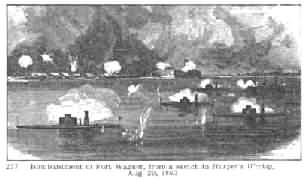
The 54th Massachusetts regiment took part in some small actions during the early part of July before being moved to Morris Island.
On July 18, 1863, the regiment, with two brigades of white troops, led an assault on the Confederate artillery battery, Fort Wagner. The men fought bravely and proved that black soldiers could fight as well as whites. However, the Union army were unable to take the Fort and many of the 54th Massachusetts regiment, including Robert Gould Shaw were killed.
Black History Following the Civil War
At the end of the American Civil War, slavery was abolished. Legally the former slaves were free and equal to white people. The reality was far different.
The Ku Klux Klan was a white underground terrorist group. They would not accept black people as equals. Members of the Ku Klux Klan dressed in white robes to stress their belief that whites were superior to blacks. As a result many black people did not register to vote and kept away from white areas.
They created a wave of terror which included threats of violence, bullying, lynching, setting fire to buildings and murder, among blacks and those who tried to help them. Blacks who tried to vote or gain an education were subjected to name calling, bullying and beatings from white people who supported the aims of the Ku Klux Klan.
Regarding black history, black americans had to face the truth. The war was won, but the battle was not over. They would have to struggle against racial discrimination in order to gain fair and equal treatment.
When Did Slavery End in America?
(See Main Article: When Did Slavery End in America?)
When did slavery end in America? While it formally ended with the Emancipation Proclamation, an executive order of Abraham Lincoln on January 1, 1863, the total abolition of slavery was a process that occurred in fits and starts throughout the Civil War.
Such legislation was said to be necessary on account of the “black codes” that had been imposed in some Southern states. These codes curtailed black liberty in various degrees and the Radicals described them as a continuation of slavery. But the codes were essentially based on Northern vagrancy laws and other restrictive legislation that was still on the books when the Reconstruction Acts were drawn up. Historian Robert Selph Henry contends that “there was hardly a feature of the apprenticeship and vagrancy acts of Mississippi, and of the other Southern states, which was not substantially duplicated in some of these Northern laws, while many of the Northern provisions were more harsh in their terms than anything proposed in the South.”
In the northeast, as well as in Indiana and Wisconsin, the vagrancy laws were as broad as anything in the South, with more severe punishments for violating them. “[O]ne without employment wandering abroad, begging, and ‘not giving a good account of himself,’ might be imprisoned as a vagrant, for periods varying from ninety days to three years, in various Northern states.”
Two modern scholars, H. A. Scott Trask and Carey Roberts, contend that the black codes have been misunderstood in their intent and exaggerated in their impact:
Most granted, or recognized, important legal rights for the freedmen, such as the right to hold property, to marry, to make contracts, to sue, and to testify in court. Many mandated penalties for vagrancy, but the intention there was not to bind them to the land in a state of perpetual serfdom, as was charged by Northern Radicals, but to end what had become an intolerable situation—the wandering across the South of large numbers of freedmen who were without food, money, jobs, or homes. Such a situation was leading to crime, fear, and violence.
14th Amendment: A Simplified Description
(See Main Article: 14th Amendment: A Simplified Description)
The 14th Amendment simplified is the amendment to the Constitution of the United States that granted citizenship and equal civil and legal rights to African Americans and slaves who had been emancipated after the American Civil War, including them under the umbrella phrase “all persons born or naturalized in the United States.”
The NAACP
(See Main Article: What is the NAACP?)
“The NAACP Leader Who Passed As White, Infiltrated Lynching Rings, Architected ‘Brown v. Board of Education’, and Ended His Life in Scandal”
For the full “History Unplugged” podcast, click here!
The National Association for the Advancement of Colored People is the largest, oldest and most well-known civil rights group. It was founded in February 1909 and now has over half a million members. The principal goal of the NAACP is to ensure social, economic and political equality of minorities in the U.S. and to eliminate racism.
The NAACP was formed back in 1909 after the 1908 race riot that took place in Springfield. The founding members were appalled by the horrible practise of lynching and the overall violent treatment of blacks in the country. Many of them were white liberals, and their first call to meet and discuss racial justice were signed by about 60 people, among which only 7 were African American. The NAACP still exists today and strives to remove all racial discrimination through democratic means.
Black History – Founding Members of the NAACP
(See Main Article: Who Founded the NAACP?)
W.E.B. Du Bois – an historian and Pan-Africanist, who was the first African-American to earn a doctorate and become a professor.
Ida B. Wells – an African-American newspaper editor and journalist. She was very involved in documenting lynching in the U.S., showing how it was often used as a way to punish or control blacks who were considered to be competition by whites.
Archibald Grimke – a journalist, lawyer, intellectual who served as vice president for the organization.
Henry Moskowitz – a Jewish civil rights activist who later served as president of NYC’s Municipal Civil Service Commission, Commisioner of Public Markets and who became the Executive Director of the Broadway League.
Mary White Ovington – a journalist, suffragist and Republican who ended up serving the organization for 38 years.
Oswald Garrison Villard – a journalist who donated space for the first meeting’s announcement in the New York Evening Post.
William English Walling – a white American labor reformer who was also a founder of the National Woman’s Trade Union League.
Florence Kelly – a political reformer who is well-respected for her fight for the minimum wage, children’s rights, 8-hour workdays and against sweatshops.
Charles Edward Russell – an opinion columnist, journalist, editor and activist.
The Jim Crow Era
(See Main Article: Black Peoples of America – Segregation – The Jim Crow Laws)
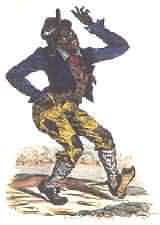
Jim Crow was a character in an old song who was revived by a white comedian called Daddy Rice. Rice used the character to make fun of black people and the way that they spoke. The term Jim Crow came to be used as an insult against black people.
In a bid to stop black Americans from being equal, the southern states passed a series of laws known as Jim Crow laws which discriminated against blacks and made sure that they were segregated (treated unequally) from whites
A black man, Homer Plessey, took a railroad company to court because he had been made to sit in a ‘coloured only’ carriage. The case went to the Supreme Court who supported the railroad company.
The ruling meant that the Jim Crow laws were legal and that it was not illegal to keep blacks and whites separate.
Because of Jim Crow Laws Blacks were excluded form all newspapers and from trading. Negroes gradually lost jobs in government, which they gained after the Civil War. Whites owned the land, the police, the government, the courtrooms, the law, the armed forces, and the press. The political system denied blacks the right to vote.
Murders were conducted in secret and in public by white men. The blacks were harassed and abused, physically and verbally. These violent acts became a part of their life. Signs were put up to separate facilities saying “whites only” and “colored” or “Negroes” appearing on parks, toilets, waiting rooms, theatres, and water fountains.
Sharecropping
The Civil War ended in December 1865 and the slaves were free. They hoped to be treated as equal citizens, being able to vote, gain an education and live peaceably and equally with the whites.
The former slaves hoped that the plantations would be divided among them so that they could provide for themselves but the plantations were returned to their former owners. Many former slaves did not want to work for wages because they would still have to do what they were told by the whites. The solution lay in sharecropping. Plantation owners broke up their estates into small parcels of land upon which the former slaves could grow their own crops. In return for seed and equipment, the sharecropper would give the plantation owner a third or a half of his crop.
Before the Civil War slaves lived in huts grouped together behind the plantation owner’s house. After sharecropping was established the former slaves lived in slightly larger huts spread our around the plantation. There are also more roads as well as a church and school.
This article is part of our extensive collection of articles on Civil Rights in the United States. Click here to see our comprehensive article on Civil Rights in the United States.
For more resources on this period of time:
Click here for our comprehensive guide on the Antebellum period.
Click here for our comprehensive guide on Civil War.
Bibliography
Slavery, Abolition and Emancipation -Brycchan Carey
Middle Passage – Dr Henrick Clarke
Olaudah Equiano – Brycchan Carey
Plantations – Thomas Jefferson Foundation
Images – Library of Congress
Jim Crow – Jim Crow Museum
Cite This Article
"Black History in the United States: Slavery, Civil Rights, Culture" History on the Net© 2000-2024, Salem Media.
April 27, 2024 <https://www.historyonthenet.com/black-history-united-states-slavery-civil-rights-culture>
More Citation Information.



